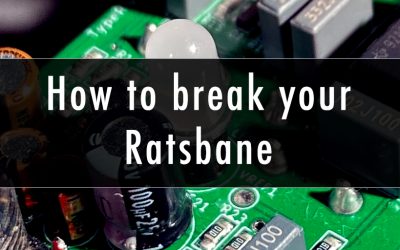
When scrolling through social media – especially gear groups – you tend to see a lot of the same misnomers and inaccurately assigned labels put on things… One of the most common is the “transparent” overdrive. I mean, how many times have you seen a K style pedal called Transparent? Quite a few I expect. It’s right up there with people saying “I need a clean boost” and someone saying “tubescreamer”.
Firstly, what is a transparent overdrive? Well, it’s one that doesn’t fundamentally change the EQ of whatever is coming into it. So, all that happens is that the pedal/circuit clips the signal, sending it to overdrive and then comes out again. These kinds of pedals are actually EXTREMELY rare as all the fun is in the EQ stack and when you start putting multiple EQ stacks into circuits, that’s when the fun really starts! bDub made a video last week that was discussing this, so I thought I would expand on it further, concentrating on the most famous transparent OD of them all – Paul Cochrane’s “Timmy”.
The Tummy has very little in the way of EQ colouration so what you put it just comes out, but clipped (on certain settings)… but before I jump head first into that rabbit hole, here is some basic information about how EQ is handled and how it is performed on most dirt pedals. Like a LOT of pedals the Timmy tone controls is not active, but passive, so it doesn’t add anything it only takes it away – think of it this way – a basic treble control is a LPF (low pass filter) that is wired backwards. It restricts the amount of bass coming through – it does NOT add treble. So, when the knob is all the way round clockwise, the treble isn’t being added, bass is being taken out. The more you bring it counter clockwise, the more bass is taken out giving the impression that there is treble being added. This is obviously different from a lot of the tone stacks that bDub puts in his pedals (which are 100% active EQ’s) so in those when the control is theoretically at noon there is nothing changed, but take the relevant frequencies away when turned counter clockwise, and then added when turned the other way. Worth noting, the bass control on the Timmy is active, but only adds bass – this is integral to the circuit and the style of clipping, and is quite similarly handled in the Euphoria pedal.
One of the things I’ve ALWAYS loved about the Timmy is that the tone pot is actually wired the correct way, so everything appears to be backwards for people who are used to other pedals. When you have the treble control all the way “off” (counter clockwise), all the treble is still in the circuit, when it is “on” (clockwise), the treble is taken out – so it’s working in the correct way… if you look at it from a nerdy perspective. This means that if you have the gain on the Timmy ALL the way down and the tone and bass control all the way up, you are hearing what I think is the most transparent overdrive currently available. Of course, as it’s going through ‘stuff’ before it gets there, and inside it, and what comes after, it will never be truly transparent but I think it’s the closest you can get, and most people won’t be able to hear any EQ difference in it – the pedal in this state is basically acting as if it were a buffer within minimal difference to anything else. The active bass control is also round the other way as well, so when the pot is all the way counter clockwise, you are getting maximum bass, and none added when it is all the clockwise.
To show this literally, we’ve made a few graphs to demonstrate it visually. Please bear in mind that these graphs start at about 50hz and go all the way up to the 10kHz, most guitar rigs won’t go lower or higher than this, so we’ve removed what happens above and below.
Here is the Timmy at its flattest, so that’s gain off and bass and tone all the way round clockwise. As you can see, that is what we would call over here in England as ‘flat as a pancake’, with a slight roll off at the very top end.

From here, we’ll change the EQ and gain controls to show what is happening in terms of the cut…
Gain 50%, Bass 0%, Tone 0%.

Gain 50%, Bass 0%, Tone 50%

Gain 50%, Bass 50%, Tone 50%

Gain 50%, Bass 0%, Tone 100%

Gain 100%, Bass 0%, Tone 0%.

Gain 100%, Bass 50%, Tone 0%.

Gain 100%, Bass 100%, Tone 0%

Gain 100%, Bass 50%, Tone 100%

Gain 100%, Bass 100%, Tone 100%

To round this up, I want to quickly remind everyone why a lot of us industry types scoff so much when TS and K style circuits are called transparent… the whole point of them is that they add a mid boost, which is what makes them push tube amps so well… the TS has its main peak at around 723hz and the K at 1k. They are anything but transparent!



I just want my sound (which includes low end content) with some hair and break up added. Why is that so hard to find? I don’t want added sparkle. I don’t want mids. I don’t want low cut.
Exactly! I don’t want to add or subtract anything from my amp EQ settings when stepping on an overdrive for more gain and volume for solos. What is that pedal?!!
That’s a boost pedal into a tube amp.
It’s a Keeley katana
“Gain all the way down and tone and bass all the way up” is NOT transparent, that’s simply no distortion! Transparent is when the guitar’s natural tone is “visible” through the mist of distortion. You need some distortion to have transparency!
Hey guys, I know this post is over 5 years old, so forgive me for commenting on it. I love the podcast, and love the pedals, but those frequency analysis charts for the Timmy above are BEYOND confusing. Sorry lol There are two where adjustments were made, but nothing changed. It is supposed to be a flat EQ pedals, but those charts appear to be anything but flat. I admit, it could just be me, but the ONLY reason I bring it up is….curiosity. Maybe I am missing something. Or, maybe an idea for a future video from Brian? Anyway, be well, and thanks for all you do!